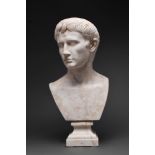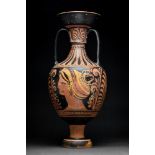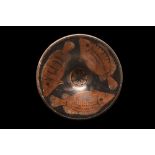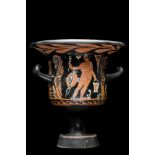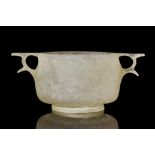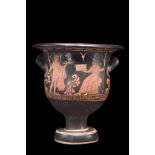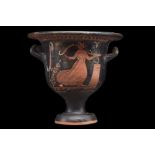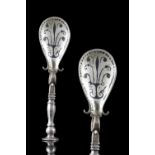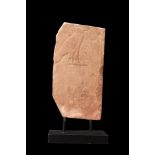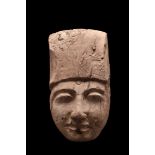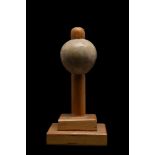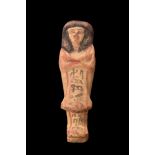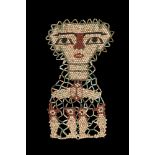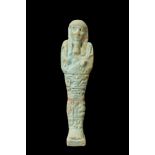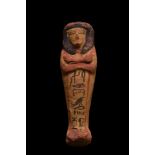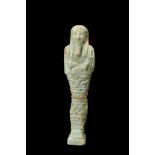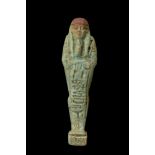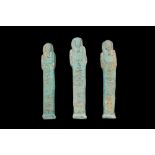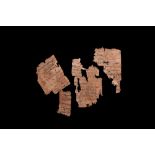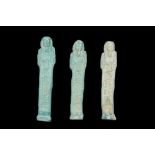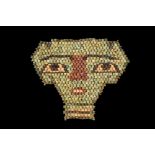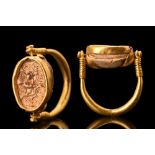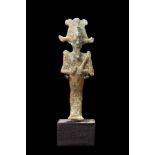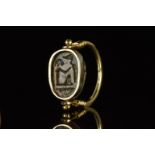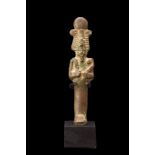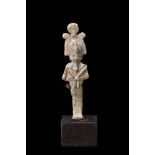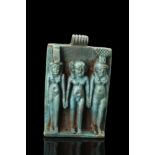Refine your search
Estimate
Category
- Jewellery (131)
- Greek, Roman, Egyptian & Other Antiquities (64)
- Coins (61)
- Ceramics (30)
- Glassware (23)
- Sculpture (20)
- Collectables (18)
- Arms, Armour & Militaria (14)
- Salvage & Architectural Antiques (11)
- Books & Periodicals (7)
- Metalware (6)
- Porcelain (5)
- Kitchenalia (4)
- Scientific Instruments (3)
- Vintage Fashion (3)
- Sporting Memorabilia & Equipment (2)
- Taxidermy & Natural History (2)
- Classic Cars, Motorcycles & Automobilia (1)
- Clocks (1)
- Furniture (1)
- Lighting (1)
- Oil, Acrylic paintings & Mixed Media (1)
- Tools (1)
- Watches & Watch accessories (1)
- List
- Grid
A subscription to the Price Guide is required to view results for auctions ten days or older. Click here for more information
Ca. 1700-1850 AD. A magnificent marble bust depicting Caesar Augustus, the first Roman emperor, with an air of regal authority, his powerful gaze,...
Ca. 500-300 BC. A striking Chalcidian helmet made of hammered tinned bronze, with a sharply flaring neck-guard, a short slender nose guard running...
Ca. late 4th to 2nd century BC. A lifesize sculpted marble head of a ram with wonderfully carved, spiral-shaped horns. The animal's head is mounte...
Ca. 323-31 BC. A stunning gold ring with its massive and flaring body is beautifully adorned with a ribbed band, and its shoulders are decorated w...
Ca. 1800 AD (or earlier). A large bronze statuette of goddess Venus standing on top of a round base with her weight on her left leg, the right leg...
Ca. 320 AD. A huge and beautiful red figure Apulian amphora. On one side is a seated, a flowering plant in an Ionic naiskos, a small temple often ...
Ca. 400-300 BC. A fish plate in a type of pinaxion, a shallow tablet-style plate, featuring a shallow rim decorated with a wave pattern and three ...
Ca. 430-300 BC. A beautiful terracotta bell krater features a pedestal foot, cylindrical flared stem, inverted bell-shaped body, two upturned hand...
ROMAN MARBLE HEAD
Ca. 100 AD. This remarkable marble female head dates roughly to the end of the first century AD (ca. 100 AD), during the reign of the Emperor Traj...
Ca. 500 BC. A lovely, black-figure pottery amphora of a classic form, with a bulbous body upon a raised, round foot, a flared rim at the top, and ...
RARE GREEK CUT GLASS SKYPHOS
Greece, late 2nd - early 1st century BC. A Greek skyphos is a marvel of ancient craftsmanship, a vessel that embodies the beauty and elegance of H...
Ca. 350-300 BC. An exquisite Apulian bell krater with its surface area painted via the red-figure technique with added fugitive yellow pigment. Si...
Ca. 350-300 BC. The krater with disc foot, short stem, bulbous body and flaring lip, two ribbon-like handles are set bilaterally, beneath the rim ...
Ca. 100-200 AD. A stunning gold finger ring of a flat-section hoop with nicely decorated shoulders and a bezel set with a carnelian intaglio depic...
Ca. 460-450 BC. A ceramic oinochoe in the form of a female head with dark brown hair swept back over the ear. Her elegant arched brow and large ey...
Ca. 100 BC - 100 AD. A stunning helmet crafted from bronze, characterized by a rounded bowl with hinged C-shaped cut-outs for the ears. The neck g...
Ca. 500-400 BC. A beautiful gold finger ring with a pointed lozenge-shaped bezel and a round-section hoop. The bezel is skilfully engraved with a ...
Eastern Mediterranean, Ca. 1st - 3rd century AD. A square fresco section depicting an eagle in flight holding an undulated snake in his talons. Ou...
Ca. 300 BC. A finely modelled skyphos from the Gnathia region of Magnia Graecia. It is made from light brown clay, which has been covered with a r...
RARE ROMAN BRONZE FOOT OIL LAMP
Ca. 100-200 AD. A beautiful cast-bronze oil lamp in the shape of a human foot. The lamp has two openings, one where a wick would be placed protrud...
Ca. 200-300 AD. A rare silver spoon featuring a pear-shaped bowl adorned with a beautiful niello design. The handle is baluster-moulded and has tw...
RARE ROMAN BRONZE FIGURE OF LION
Ca. 100-200 AD. A stunning bronze figurine of a lion in a reclining position with its forelegs outstretched forward and a full, bushy mane. The li...
Ca. 100-300 AD (intaglio), ca. 1700-1800 AD (brooch). A remarkable example of neoclassical jewelry, featuring a Roman stone oval-shaped intaglio t...
Third Intermediate Period, Ca. 1069-730 BC. An object of beauty and imagination; a mask from the lid of an anthropoid coffin, painted in pigment o...
Old Kingdom, ca 2300 BC. A sandstone relief section of the sub-rectangular form, carved in raised relief with the bust of an offering bearer in pr...
New Kingdom, 18th Dynasty, ca. 1550-1292 BC. An exquisite bronze dagger characterized by its tapering pointed blade with a raised mid-rib, which i...
Late Dynastic Period, Ca. 664-332 BC. Late Dynastic Period, Ca. 664-32 BC. A carved sarcophagus mask formed from a finely-grained cedar wood. The ...
Late Period, Ca. 664-332 BC. The surface features a scene made up of 4 columns of text. In the upper register, the solar boat is represented, with...
Pre-Dynastic, Ca. 3500-3000 BC. A rare piriform alabaster mace head with a cylindrical drill hole in the centre for attachment to a wooden handle....
New Kingdom, 19th - 20th Dynasty, ca. 1292-1085 BC. A well-moulded terracotta ushabti, wearing the tripartite wig, holding hoe and mattock, basket...
Roman Period, Ca. 31 BC. A sheet of papyrus inscribed with demotic text in black ink. Demotic was used specifically for writing detailed documents...
Late Period, Ca. 664-332 BC. A mummy shroud composed of threaded faience beads arranged in a net pattern, which collectively form a remarkably det...
Late Period, Ca. 664-332 BC. A blue faience ushabti. The mummiform figurine wears a tripartite wig, his crossed hands hold hoes, and a seed bag ha...
New Kingdom, 19th - 20th Dynasty, Ca. 1292-1085 BC. A well-moulded terracotta ushabti, wearing the tripartite wig, holding hoe and mattock, basket...
Late Period, Ca. 664-332 BC. A funerary shroud, meticulously composed of faience beads arranged in a distinctive net pattern. The shroud's captiva...
Late Period, Ca. 664-332 BC. A mummiform figure in the form of an ushabti, moulded in a light-blue, glazed faience, wearing a tripartite wig and d...
Ca. 664-525 BC. A funerary statuette with a mummy-shaped body and back pillar standing on a small base plate. Modelled details, wearing a triparti...
Late Period, 30th Dynasty, Ca. 332 BC. A group of three light blue faience ushabti figures, each wearing a tripartite wig, a false beard, and with...
Roman Period, Ca. 31 BC. A fragment of papyrus inscribed with demotic cursive script. Demotic was the fourth phase of the Egyptian language, used ...
Late Period, 30th Dynasty, Ca. 332 BC. A group of three ushabti figures, each moulded in a light-blue, glazed faience, wearing a tripartite wig an...
EGYPTIAN FAIENCE MUMMY MASK
Late Period, ca. 663-323 BC. A beaded mummy mask made of delicate faience beads in green, cream, red, and black. The face is highly stylised with ...
New Kingdom, ca. 1550-1069 BC. A golden amulet in the shape of a tilapia fish. A cast gold amuletic bead with a suspension hole through the centre...
Ca. 500 BC. A museum-quality scarab ring in common fashion on top but the base when swiveled reveals a field of numerous circles.Size: D: 10 1/4mm...
EGYPTIAN BRONZE OSIRIS
Late Dynastic Period, ca. 664-332 BC. A bronze figurine depicting upright Osiris wearing an Atef crown, plumed on each side with ostrich feathers ...
Ca. 1570-1070 BC. A finely modelled swivel ring featuring a gold bezel incorporating a glazed composition scarab inscribed to the underside. The r...
EGYPTIAN BRONZE OSIRIS
Late Dynastic Period, ca. 664-332 BC. A bronze figure of Osiris in mummiform position holding the crook and flail. He is depicted with a braided d...
Amarna Period, ca. 1353-1336 BC. A gold amulet in the form of a lotus petal featuring a delicately formed suspension loop on the top. This amulet ...
EGYPTIAN ALABASTER VESSEL
Ca. 3000 BC. A cream-coloured alabaster vessel with a flat base, tapering sides and an outward flaring rim. This elegant object may have been used...
EGYPTIAN BRONZE OSIRIS
Late Dynastic Period, ca. 664-332 BC. A bronze figure of God Osiris shown mummiform with a braided divine beard curved out at its tip, an atef-cro...
Ca. 400 BC. An onyx scaraboid engraved to the underside with a standing figure holding a palm branch. The gemstone has been set in a gold swivel r...
EGYPTAIN STONE VESSEL
Old Kingdom, ca. 2686-2160 BC. A handsome vessel, meticulously crafted from stone that exhibits a stunning texture and form. The vessel's smooth a...
Roman Period, Ca. 31 BC. Fragment of a papyrus inscribed with demotic cursive script. Demotic was used specifically for writing long arduous docum...
EGYPTIAN ALABASTER VESSEL
Ca. 2000 BC. An alabaster vessel of a wide and shallow body, stepped-in flange, and raised rim. The vessel sits on a flat base, giving it stabilit...
EGYPTIAN ALABASTER CONICAL BOWL
Early Dynastic Period, ca. 2750-2649 BC. A beautiful conical bowl, with tapering walls and a flat base. Sculpted to exploit the natural veining of...
EGYPTIAN FAIENCE MUMMY MASK
Late Period, ca. 663-323 BC. A face mask composed of turquoise, cream, black and red faience glazed composition beads, with cream for the sclera, ...
EGYPTIAN ALABASTER CONICAL BOWL
Early Dynastic Period, ca. 2750-2649 BC. A skillfully carved alabaster bowl, featuring a conical-shaped body with walls flaring outwards, creating...
Ca. 2nd millennium BC. A stone mortar and pestle set. The mortar of simple, cylindrical form, slightly flaring to its base. The pestle with a broa...
EGYPTIAN GLAZED ANUBIS AMULET
Late Period, ca. 664-332 BC. A glazed composition amulet of reclining Anubis, the ancient Egyptian god of mummification and the afterlife. This am...
Ca. 660-525 BC. A glazed composition flask decorated on one side with a rosette and the other with Anubis, the ancient Egyptian god of the dead. T...
Late Period, ca. 700-30 BC. A glazed composition amulet featuring a relief triad of Horus, Isis, and Nepthys. The amulet is rectangular in shape w...

